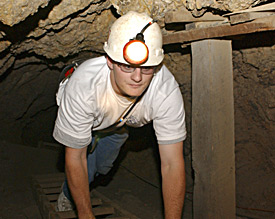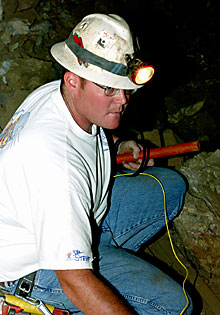 |
|
CHRIS CODUTO/Arizona Daily Wildcat
|
Mining engineering freshman Jeffrey Kinney climbs up a ladder at the San Xavier mine. The mine is operated by the College of Engineering and Mines, and is designed to provide hands-on experience for the mining students.
|
|
|
By Nathan Tafoya
Arizona Daily Wildcat
Thursday, November 6, 2003
Back-dropped by a low hill, dusty men and women emerge from a mine entrance, turning off their hard hat lights and taking off their work belts.
Students in UA's department of mining and geological engineering experience the contemporary and often complex side of the mining industry the rest of us never see, by working at a laboratory donated to the UA in 1975.
The San Xavier Mining Laboratory is the only facility of its kind in the United States because of its working vertical shaft and because it is structured much like an operating mine.
The lab, approximately 23 miles away from the UA, is entirely student-run.
"We run equipment, run drills ... working, you know, maintenance here and there," said Claudio Cossio, a mining engineering senior. "We come out here every Saturday from 8 a.m. to 4 p.m."
The student mine management is responsible for nearly every facet of the facility, including safety programs, mine planning, regulatory compliance and most administrative functions.
While clocking in the usual eight-hour shifts per week at the mine, engineering students are exposed to some of the latest technological advances in mining and excavation through hands-on training.
Even though he receives no credit or pay for the eight-hour days, Cossio said the commitment is not a waste of time.
"It's a small mine, but you get an idea of what it's like in the real world," he said.
Cossio was in Georgia this past summer working with a company constructing tunnels 18 feet in diameter for a 10-mile subway system.
Job placement for mining engineering is 100 percent, said Hugh Miller, associate professor and director of the mines. The high demand makes it the second or third highest paying degree, surpassing civil engineering.
As a McNair Scholar, a reward given to first generation minority students, Cossio was supposed to undergo a summer internship performing research on water jet excavation for oil reservoirs.
 |
|
CHRIS CODUTO/Arizona Daily Wildcat
|
Student mine manager and mining engineering senior Steve Shipley sets an explosive charge in the San Xavier Mine earlier this year. Shipley, and the rest of the student mine management team is responsible for nearly every facet of the San Xavier facility, including safety programs, mine planning, regulatory compliance and most administrative functions.
|
|
|
Due to the job in Georgia though, Cossio is doing the research this semester. His research seeks to find cheaper and more efficient ways to fragment rocks for oil reservoirs, a process called water-jet excavation.
"It's just like if you were to use drills, but you use water instead," Cossio said.
Cossio added that he is happy to be in the college because of the interaction between the faculty and students.
"I'm having fun in college," Cossio said. "Before I joined the department, I was a miserable guy, as far as education goes. I didn't know what I wanted to do or if I'd like it or not."
Miller said that there are 26 undergraduates declared in geological engineering, 22 in mining engineering and 29 graduate students.
"Because we have a small department, I know them by first name," said Elsie Nonaka, the department's administrative assistant.
Mining engineering senior Cheikh Chekroud, said other students in the department are like a family to him.
Chekroud is the seventh person that Societe Nacional Industral Minier, the only mining company in Muaritania, Africa, has sent to the UA.
Chekroud said the unity in the department has helped him cope with being so far away from home.
"I feel very comfortable talking to them about anything I need help with, and that makes it easier," he said.
Aside from camping out at the laboratory mine and doing other bonding activities, students in the department of mining and geological engineering know how to get serious about their lab
projects. "Everything is done by students here," said Cossio. "It's pretty much just mining - but not for profit. Just mining for fun."
Students at the mine handle explosives, heavy drills and even heavier automation."Not too many other college students get to go out and blow stuff up legally," said Rolla Holland, an engineering management junior.
Jessica Morgan, president of the Society of Mining Engineers, said that since the mine was donated to the UA, students have built the horizontal entryway into the mine.
"We can do anything we want out here because it is an experimental mine," Morgan said.
Students land survey and develop the mine, removing dirt and minerals from inside the mineshafts.
They use the lab for class projects and for experience with tools they know will be necessary for post-graduate employment.
But the helter-skelter attitude once fostered by the mining industry has changed over the decades and is reflected in the way mining is taught at the UA.
According to Miller, environmental consideration, along with occupational health and safety, are high priority in the department's curriculum.
"We want to be a good neighbor," Miller said. "Teaching environmental stewardship is part of what we teach up here. That's the nature of the business now."
Morgan said after the Sunshine Fire disaster in 1972, mining companies have taken pride in having a good safety record.
Mining sophistication has come in the form of technology too.
"It's not only the ax and shovel," said Chekroud. "It's much more advanced than that. It has a wide range from designing to business stocks."
Miller said mining now consists of autonomous vehicles and robotics, information technology and global positioning systems.
Global positioning systems can be used to find optimal paths trucks to get to pits. Mines can now be monitored from excavation to final product.
Despite all the technology, in the underground shafts, the newest generation of miners can still pass by pillars of wood used at the turn of the century, a reminder of how far mining has come.
"I'm so glad I'm here," said Cossio. "That's why I'm thinking about graduate school. I don't want to leave."
